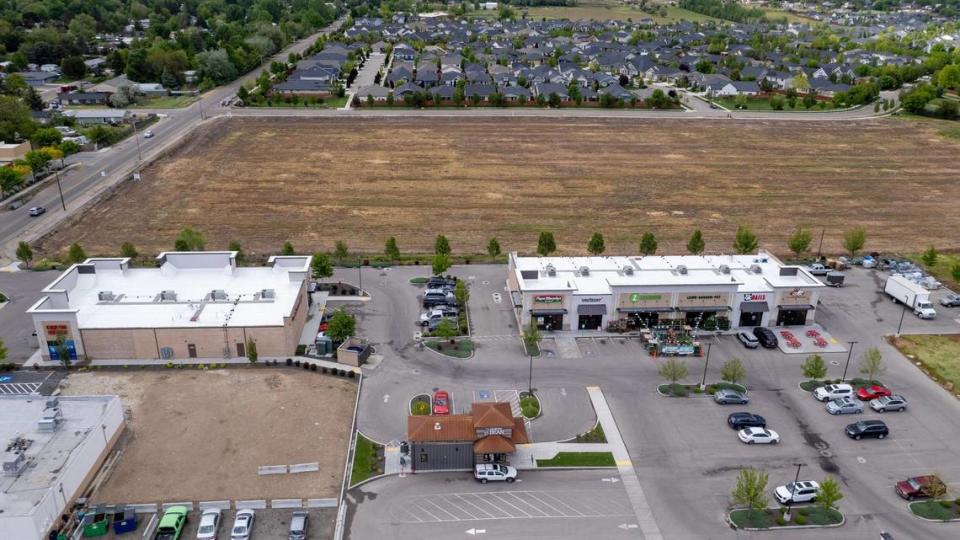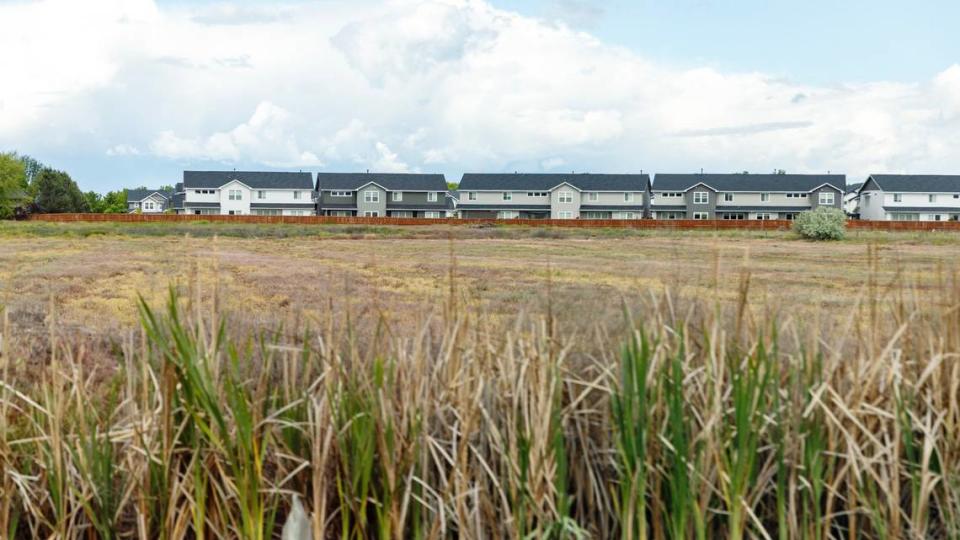Spend some time in Southwest Boise and it can feel like you’ve been shipwrecked in a sea of houses, with rooftops stretching for miles in every direction.
While the homes — some virtual carbon copies of each other — have served as a bulwark against a continued housing shortage, residents see the area as commercially barren. For many, there’s an almost unbearable lack of spots to grab a bite to eat or shop for clothes without spending half an hour locked in a car.
Frustrations have simmered over this commercial desert for years and came to a head in January when the Board of Ada County Commissioners heard hours of public testimony against turning one of the last remaining chunks of land in the area zoned for commercial uses into more homes.
Citing neighbor complaints, the board made a final decision Wednesday to reject the proposed $45 million project from the Utah-based Peg Cos. that would have built 118 homes and 20,000 square feet of stores on a vacant 10-acre parcel.

Commissioner Ryan Davidson, who won his race against challenger Clyde Dornier in Tuesday’s Republican primary election, said he has spoken with constituents lately and heard more opposition against high-density projects such as Peg’s proposal.
“Overall, we support commercial development and residential development as well,” Davidson said. “But after hearing a lot of public testimony, I think that this is not a project that would be a good fit for this neighborhood.”
This is the second time the project, called Alante Homes at Hazelwood Village, has gone in front of the commissioners after the board rejected Peg’s 2022 proposal that included homes only. The board asked Peg to add commercial elements to the plan, which it did.
“We’re just disappointed because really, the only reason we’re here the second time around is because of specific feedback that the commissioners gave us … which we followed exactly,” said David Bourne, director of investments for Peg. “I don’t know if they were sincere in their desire to have us do that or if they were always going to fold if faced with opposition from neighbors.”
The project would have included 20 one-bedroom, 37 two-bedroom and 61 three-bedroom rental homes, according to prior Idaho Statesman reporting.
The units would have included single-family and duplex offerings running from an average of $1,700 to $2,500 per month, according to prior Statesman reporting. The developers proposed including a private park, clubhouse, pool, pickleball courts and a playground.
The 20,000 square feet of commercial space on the eastern side of the property would have fit six to 12 businesses, Bourne said in a January meeting.


Bourne said that while he believed a lot of neighbors were well-intentioned, he’d never seen such a clear case of NIMBYism, an acronym that stands for “not in my backyard” and refers to neighborhood opposition to development.
Residents celebrated the board’s decision Wednesday, hoping the site could someday serve the neighborhood better.
“The whole key of planning is to preserve the commercial to support the houses that go out there,” said Gerry Armstrong, a nearby resident and the former director of planning and development at Ada County.
Armstrong said a goal of planning is to build a community and that there is a lack of gathering spaces to do so in Southwest Boise.
“You want people to come together and have their coffee, go out to breakfast together,” Armstrong said.
Dwindling hope for mixed neighborhoods
Carlos Vidales, a nearby resident who led much of the opposition to the project, said there were about 80 acres in the area reserved for commercial uses. Then it dropped to 50 acres as developers rezoned it for homes. A few businesses including an Albertsons, McDonald’s and Idaho Central Credit Union snagged some of that acreage, leaving the 10-acre parcel as some of the last available land.
“This parcel is the last of that,” Vidales said.
According to Armstrong, who helped put together the land-use map of the area, there was concern that developers would fill Southwest Boise with strip commercial like along Fairview Avenue.


Instead, they wanted to build small “commercial villages” clustered around intersections that could offer places like barber shops and cafes, Armstrong said.
As developers rezoned the region for more houses, those goals began to disappear, he said.
Now, there is barely any available land in the area that can be used for anything other than homes, Vidales said.
“Just about everybody I know … has been counting on it being businesses there,” said Vidales. “There’s a lot of pent-up demand.”


What would more homes do to congested roads?
Like many Southwest Boise developments now worming their way through the entitlement process — such as the nearly 381-acre Murio Farms project and the proposed Syringa Valley project — one of the biggest concerns for local residents is clogged roads.
Murio Farms is a roughly 1½ mile drive from the 10-acre piece of land Peg wanted to rezone.
Several local residents testified in front of Boise City Council in early May on Murio Farms, saying that the roads in the area can’t support the amount of development.
“We are getting so many additional homes in the area that the infrastructure can’t keep up,” said Estee Lafrenz, president of the South Cole Neighborhood Association, during that meeting.
Even though plans for Murio Farms include some commercial areas, Vidales said they likely wouldn’t start building businesses there for over 10 years.
For now, the vast majority of commercial opportunities for Southwest Boise residents are to the north — forcing residents to cram onto a few roads like Cloverdale, Five Mile or Maple Grove to pick up supplies.
“We all have to drive long distances,” Vidales said. “We need the businesses so we don’t congest the roads all over Ada County.”
What next for Southwest Boise site?
There are still some avenues for Peg’s project to come to life, Bourne said, though they are unlikely.


The most likely option for the site now? A 24-hour self-storage site, Bourne said.
“I don’t think it’s the best use for this neighborhood,” he said. “It denies a lot of the things that Ada County claims to be looking for.”


With current zoning, turning the vacant lot into self-storage wouldn’t require any type of public hearing, Bourne said. It would just need administrative approval.
No developer will see how Peg was treated and want to move forward with a plan to mix homes and businesses there, Bourne said.
“There will never be a shop or a restaurant on that site,” Bourne said.
Boise development would add 3,500 homes. Why staff analysts say it’s a bad deal
What happens when you build houses, but no stores? This Boise neighborhood is finding out
Multistory apartment building could come to this busy Boise Bench area. Are you ready?
Dream to bring 1,500 homes to South & Southwest Boise still on the table. Here’s the plan
Source Agencies



